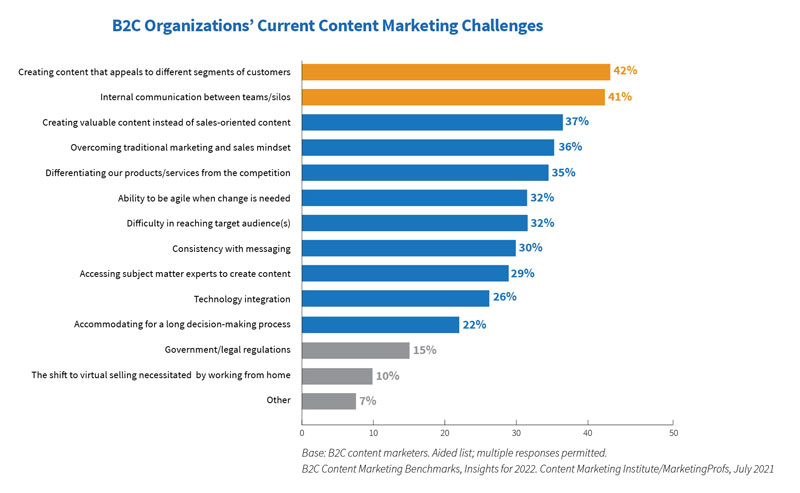Content marketing has the potential to generate leads, interest, and revenue. However, content teams struggle with a variety of factors that impact their success. The biggest content marketing challenges your enterprise team faces aren’t something you have to work around. There are ways to overcome them with the right strategy, processes, and technology.
If content marketing challenges have you feeling frustrated, you’ll want to keep reading this article for insights.
Content Marketing Challenges: The Big 4
Every organization has a unique content strategy and goals. The fundamentals remain the same, as do the struggles. Here are the challenges our experts are tracking.
Creating Content That Resonates with Multiple Personas
Often, content marketing challenges revolve around the “who.” Except you don’t have just one type of audience. You have many personas, some with decision-making ability and others that are influencers. As a result, content must be multidimensional and balance a variety of needs by buyers. Creating this kind of content was the number one challenge cited by content marketers in the Content Marketing Institute (CMI) Content Marketing Survey.
Image: CMI
It’s a struggle that has many factors. First, you have to know your audience really well. Then you’ll need to gather these insights directly from customers, research, data, and other customer-facing teams (e.g., sales, customer service, product managers, etc.). Third, you’ll have to map out your content calendar to have a variety of posts for different personas so the message resonates with them.
To do this well and often, you should:
- Update customer personas often, especially if something significant occurs that would change their motivations or objections.
- Align projects to your content pillars so you stay true to core messaging that you know matters to the audience.
- Personalize content as much as possible for the role with posts, videos, interactive content, and more, which you can distribute to segments with email marketing.
- Keep an eye on your content performance data to determine which content format, pain point, or topic generates the most interest.
Technology like a content marketing platform will help you execute these things and keep you organized and all parties aware.
Determining Content Marketing ROI
Calculating the ROI of your content marketing remains a thorn in the side of content marketers. The CMI survey found that 51 percent of marketers were average in their ability to do this. ROI is critical to demonstrate how content marketing contributes to revenue and sales. You need to prove this to avoid losing budget dollars or headcount.
Image: CMI
You can determine ROI more consistently by aggregating and analyzing all content analytics in one space. Some of this data will be easy to measure, such as leads acquired, click-through rates (CTR), and traffic metrics. You can determine MQLs (marketing qualified leads) produced and more with these.
Other parts of content ROI are subjective and specific to your content goals. In these scenarios, you can better validate the value of content marketing by:
- Identifying KPIs (key performance indicators) that align with the company’s objectives.
- Isolating the most critical metrics that tell the story of how content attracts and converts audiences (e.g., organic traffic, user actions, etc.).
- Looking beyond the numbers to understand how content plays a role in the customer journey. After all, B2B buyers consume 13 pieces of content before they’re ready to talk to sales, so your targets are likely interacting with your content on many levels.
Accessing Subject Matter Experts
Content that’s relevant and specific will draw in an audience. If it describes their pain points and issues, they are all ears. Often, you need help from SMEs (subject matter experts) to give the piece some color. They have the inside track on what your audience needs and what your company offers.
Pinning them down for calls or reviews can be a struggle, with 42 percent of content marketers naming it as their biggest challenge. These folks are busy, but they need to understand the value they can create by participating in content. Some ways to improve the relationship include:
- Setting up expectations from the start on how they need to contribute to the project.
- Getting their buy-in on the power of content marketing to educate and convert.
- Providing them access to your content calendar and other tools, so they can provide feedback on articles as a task.
The conundrum with SMEs isn’t the only disconnect in enterprise content marketing. Internal communication is a struggle, too.
Internal Communication Dysfunction and Silos
Communication within your content team, marketing department, sales, customer service, product marketing, and more affect the quality of your content. With so many stakeholders distributed throughout the organization, it’s easy for silos to develop. Thirty-eight percent of content marketers identified it as their top challenge.
When you have silos, you have problems. There may be duplication of efforts, inconsistency in message and voice, and lack of access to content analytics. It’s time to break down the walls and collaborate effectively. Here’s how.
- Get buy-in and top-down support for organizational change and standards around content production.
- Create a culture of information sharing and communication, so everyone remains on the same page.
- Ensure all parties that contribute to content have access to your content strategy.
- Define content workflows so that all parties know their roles in taking a piece from conception to publication.
- Use content marketing software that provides visibility and transparency on all projects.
When you have these in place, you’ll find your team is more productive, and the quality of content increases.
Content Marketing Challenges: Overcome Them with DivvyHQ
Challenges your team confronts daily are opportunities — to improve, grow, evolve, and thrive. When you have a technology solution like DivvyHQ, these opportunities are much easier to grasp and sustain. It’s a central platform that becomes the framework for your content efforts, from ideation to measurement.
See how it can inspire your team by requesting a demo today!


